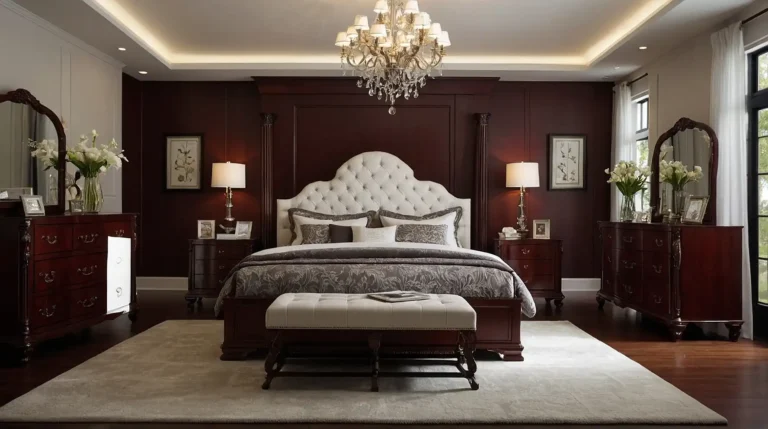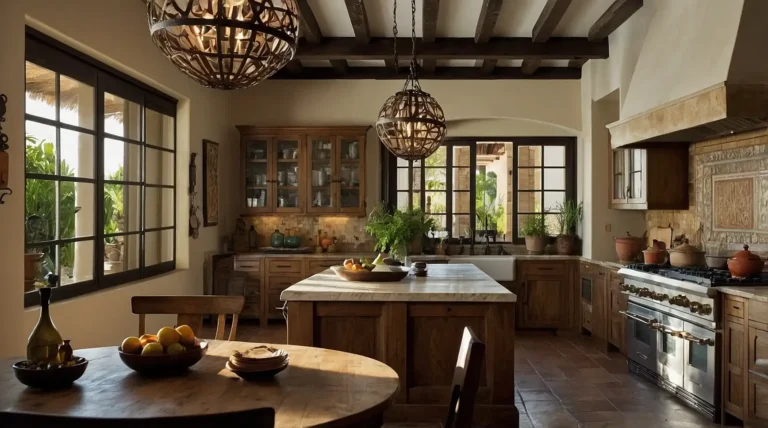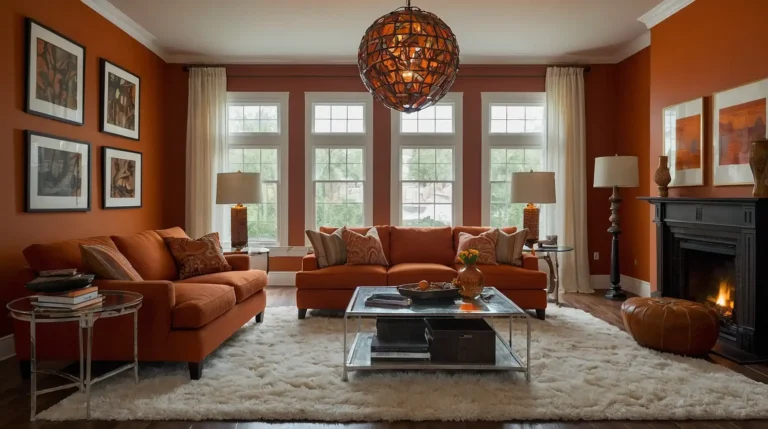27 Fresh Modern Living Room Ideas to Transform Your Space
Your living room serves as the heart of your home – a place to entertain guests, unwind after a long day, or gather with family for movie night.
Modern design offers clean lines, comfortable functionality, and eye-catching aesthetics that create a welcoming atmosphere for everyone who enters your space.
Ready to refresh your living area with contemporary style?
These 27 modern living room décor ideas will help you transform your space from ordinary to extraordinary.
1: Statement Lighting Fixtures

Replace standard ceiling lights with bold, sculptural lighting that doubles as art. Oversized pendant lights or geometric chandeliers instantly draw the eye upward.
Modern fixtures in metals like brass or matte black create visual interest even when turned off.
Consider dimmable options to adjust the mood for different occasions.
The right statement light creates a focal point that anchors your entire design scheme.
2: Minimalist TV Wall Design

Create a sleek entertainment center by mounting your TV on a clean, uncluttered wall. Hide cables inside the wall or use simple cable management solutions.
Pair with floating shelves in contrasting materials like wood against concrete or white against dark paint.
This approach removes visual clutter while maintaining functionality.
The minimalist setup allows your screen to blend into your decor rather than dominating the space.
3: Geometric Area Rugs

Anchor your seating arrangement with a rug featuring bold geometric patterns.
Look for designs with intersecting lines, abstract shapes, or asymmetrical color blocks.
Choose colors that complement your existing palette while adding visual texture. The right rug ties together disparate furniture pieces into a cohesive arrangement.
This simple addition instantly modernizes your space while adding warmth underfoot.
4: Mixed Material Coffee Tables

Select coffee tables that combine different materials for visual interest. Glass tops with wooden or metal bases create a lightweight, contemporary feel.
Consider unexpected combinations like marble with brass, concrete with walnut, or smoked glass with blackened steel. These juxtapositions feel intentionally modern.
The coffee table sits at the center of your living space, making it the perfect piece for a material statement.
5: Accent Wall with Dimensional Panels

Transform a flat wall with 3D wall panels in geometric patterns. These textured surfaces create shadow play as light changes throughout the day.
Install across an entire wall or in a specific area to highlight architectural features. Paint in a single color for subtle texture or use contrasting colors for bold impact.
This architectural element adds depth and interest without requiring additional decor pieces.
6: Curved Furniture Silhouettes

Balance the angular lines of modern design with curved furniture pieces. Look for sofas and chairs with gentle arcs, rounded backs, or curved arms.
These organic shapes feel inviting and comfortable while remaining distinctly contemporary. Pair with rectangular tables or shelving to create pleasing contrast.
The softened edges make your space feel more welcoming and less rigid than strictly linear designs.
7: Monochromatic Color Scheme

Create sophisticated depth by using varying shades of a single color throughout your living room. Choose a base color like navy, gray, or sage green.
Incorporate lighter and darker variations through furniture, walls, and textiles.
Add texture through different fabrics and materials to prevent the space from feeling flat.
This restrained approach feels intentionally modern while remaining timeless and adaptable.
8: Oversized Art Installation

Make a dramatic statement with an oversized piece of artwork or a gallery wall of complementary pieces.
Choose abstract or contemporary subjects for a modern feel.
Scale matters – select pieces that occupy at least two-thirds of the wall height for maximum impact.
Consider unframed canvas or minimalist frames to maintain clean lines.
Your art becomes the room’s focal point and sets the tone for your entire design scheme.
9: Open Shelving Displays

Replace traditional closed cabinetry with open shelving for a lighter, more contemporary look.
Install floating shelves with hidden brackets for a clean, minimal appearance.
Curate displays carefully with a mix of functional and decorative items. Maintain plenty of negative space to avoid a cluttered look.
This approach showcases your personality while maintaining the open, airy feeling essential to modern design.
10: Natural Elements Integration

Balance sleek modernity with organic materials like wood, stone, or plants. Large indoor plants in simple planters add life to minimal spaces.
Incorporate wood through furniture pieces, ceiling beams, or accent walls.
These natural elements create warmth that prevents modern rooms from feeling cold or sterile.
The contrast between natural textures and clean architectural lines creates visual harmony and depth.
11: Low-Profile Sectionals

Choose seating that combines comfort with contemporary design. Modern sectionals feature clean lines, minimal tufting, and lower seat heights.
Select performance fabrics in solid colors or subtle textures that resist stains and wear.
The expansive seating accommodates gatherings while maintaining a streamlined appearance.
This foundational piece sets the tone for your living room’s comfort level and aesthetic direction.
12: Smart Home Integration

Incorporate technology discretely into your living space. Hide speakers within walls or ceiling, install smart lighting systems, and use voice-activated controls.
Consider motorized window treatments, temperature controls, and entertainment systems that you can manage from your phone.
Modern living embraces technology without showcasing it.
These invisible upgrades create a seamless experience that enhances your daily life without visual clutter.
13: Asymmetrical Arrangements

Break away from traditional symmetrical layouts by creating intentionally balanced asymmetry.
Position your sofa off-center and balance with chairs or plants of different heights.
Place side tables of varying sizes around your seating area. This deliberately uneven approach feels more curated and contemporary than matched pairs.
The key is creating visual weight distribution that feels intentional rather than random.
14: Neutral Base with Bold Accents

Start with a neutral foundation of whites, grays, or taupes for walls and larger furniture pieces. Add personality through vibrant accent pieces in focused areas.
Introduce bold colors through pillows, art, or a single statement furniture piece. This approach allows you to update your look easily without major renovations.
The controlled pops of color create energy while maintaining the clean, sophisticated feeling of modern design.
15: Mixed Metals Fixtures

Combine different metal finishes throughout your space for a collected, contemporary look.
Mix brass lighting with blackened steel table bases or chrome accessories.
Limit your palette to 2-3 metal tones to maintain cohesion. The varied finishes add depth and interest to your space while remaining distinctly modern.
This approach moves beyond matched sets into more sophisticated, layered design territory.
16: Conversation Pit Seating

Create an intimate gathering space by arranging seating in a U or circular formation.
Consider modular pieces that can reconfigure for different social situations.
Remove the TV as the focal point and instead orient furniture toward each other to encourage interaction. Add a central coffee table to complete the arrangement.
This people-focused layout honors the room’s primary function as a space for human connection.
17: Vertical Garden Features

Bring life to your walls with vertical plantings or living walls. Install modular planting systems or arrange wall-mounted planters in geometric patterns.
Choose low-maintenance plants like succulents, air plants, or pathos varieties.
The living tapestry adds texture, improves air quality, and connects your interior to nature.
This biophilic element adds drama while satisfying our innate need for natural connection.
18: Floor-to-Ceiling Curtains

Elevate your windows with drapery that extends from ceiling to floor, even if your windows don’t.
This designer trick creates the illusion of height and architectural importance.
Choose solid fabrics in textural weaves rather than busy patterns.
Install tracks recessed into the ceiling for the cleanest look, or use simple rod systems in matching metals.
The vertical emphasis draws the eye upward and makes your ceilings appear higher.
19: Floating Furniture Placement

Pull furniture away from walls to create a more intentional, curated arrangement. Allow pieces to “float” within the room, defining conversational areas.
This approach works particularly well in open-concept spaces where you need to define zones without walls.
Consider a console table behind the sofa as a boundary marker.
The breathing room around pieces creates a more sophisticated, deliberately designed appearance.
20: High-Contrast Color Blocking

Create dynamic visual interest with bold color blocking in your space. Pair deep charcoal with crisp white, or navy with pale blush tones.
Apply contrasting colors to different architectural elements like walls versus trim, or upper walls versus lower walls.
The sharp delineation feels purposeful and contemporary.
This graphic approach brings energy and definition to your living space.
21: Statement Ceiling Treatments

Transform your “fifth wall” with unexpected treatments like painted patterns, architectural panels, or exposed beams.
A bold ceiling draws the eye upward and expands the perceived space.
Consider wallpaper, wooden planks, or even metallic paint for dramatic effect.
This often-overlooked surface provides major design impact with relatively simple implementation.
The unexpected treatment creates a complete envelope of design rather than focusing solely on horizontal surfaces.
22: Multipurpose Furniture Solutions

Embrace pieces that serve multiple functions in your modern living space.
Look for coffee tables with storage, sofas that convert to guest beds, or nesting tables that expand as needed.
Choose quality construction and clean lines to maintain the modern aesthetic. These practical solutions maximize your space while minimizing visual clutter.
This approach honors the modernist principle that form should follow function.
23: Layered Textures in Neutral Tones

Create visual interest without color by layering various textures in similar tones.
Combine smooth leather with nubby boucle, sleek metals with rough concrete, or matte finishes with high gloss.
Maintain a tight color palette while exploring tactile contrast. This sophisticated approach feels intentionally curated rather than accidentally assembled.
The depth created through texture rather than pattern or color feels distinctly contemporary.
24: Architectural Lighting Solutions

Move beyond decorative fixtures to incorporate architectural lighting that highlights your space’s best features.
Install LED strips under floating shelves or along ceiling coves.
Use wall-washing techniques to emphasize textured surfaces or art installations.
Proper lighting transforms your space and creates different moods throughout the day.
This technical approach to illumination distinguishes truly modern spaces from more traditional setups.
25: Statement Doorways and Transitions

Transform interior doorways into design features with oversized proportions, unique materials, or distinctive hardware.
Consider pivot doors, sliding panels, or archways with clean lines.
These transitions between spaces become architectural moments rather than mere necessities.
The intentional approach to openings creates a more cohesive design story.
This attention to transitional spaces elevates your entire home’s design language.
26: Customized Built-In Solutions

Maximize functionality with built-in elements designed specifically for your space. Custom media walls, window seats, or storage solutions create a tailored look.
Design these elements with clean lines and minimal ornamentation to maintain the modern aesthetic.
The perfect-fit approach eliminates awkward gaps or wasted space.
These architectural solutions feel more permanent and intentional than freestanding furniture.
27: Reflective Surfaces Strategic Placement

Incorporate mirrors and other reflective elements to expand your space visually.
Consider mirrored coffee tables, polished metal accessories, or glass room dividers.
Position mirrors to reflect light sources or green views from windows.
These reflective surfaces bounce light throughout your space, creating a more dynamic environment.
The added dimension makes your living area feel larger and more connected to its surroundings.
Conclusion
By incorporating these modern living room ideas, you’ll create a space that feels both contemporary and timeless.
Mix and match these concepts to develop a personalized sanctuary that reflects your unique style and meets your everyday needs.







